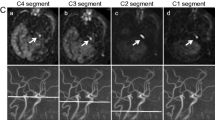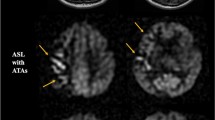Abstract
Objectives
To evaluate the diagnostic accuracy of super-selective pseudo-continuous arterial spin labeling (ss-pCASL) at depicting external carotid artery (ECA) perfusion territory in moyamoya disease (MMD).
Methods
In total, 103 patients with MMD who underwent both ss-pCASL and digital subtraction angiography (DSA, the reference standard) were included. There were 3, 184, and 19 normal, preoperative, and postoperative MMD hemispheres, respectively. The ss-pCASL results were interpreted by two different visual inspection criteria: presence or absence and definite or indefinite ECA perfusion territory. The performance of ss-pCASL at depiction of ECA perfusion territory was compared to that of DSA. The sensitivity, specificity, positive predictive value, negative predictive value, and accuracy were calculated. The κ statistic was used to assess intermodality and inter-reader agreement.
Results
When interpreted as presence or absence, the sensitivity, specificity, positive predictive value, negative predictive value, and accuracy of ss-pCASL for depicting ECA perfusion territory were 78.3 %, 79.6 %, 92.5 %, 53.4 %, and 78.6 %, respectively, and the intermodality and inter-reader agreement were κ = 0.49 (CI: 0.43 – 0.55, p < 0.01) and 0.71 (CI: 0.66 – 0.76, p < 0.01), respectively. When interpreted as definite or indefinite, the respective values were 61.1%, 100%, 100%, 44.5%, 70.4%, κ = 0.42 (CI: 0.37 – 0.47, p < 0.01), and 0.90 (CI: 0.87 – 0.93, p < 0.01).
Conclusion
ss-pCASL has substantial sensitivity and specificity compared with DSA for depicting the presence versus absence of ECA perfusion territory in MMD. As a noninvasive method in which no ion radiation or contrast medium is needed, ss-pCASL may potentially reduce the need for repeated DSA examination.
Key Points
• Super-selective pseudo-continuous arterial spin labeling (ss-pCASL) is a noninvasive vessel-selective MR technique to demonstrate perfusion territory of a single cerebral artery.
• Compared with digital subtraction angiography, ss-pCASL has substantial sensitivity and specificity for depicting the perfusion territory of the external carotid artery in brain parenchyma in moyamoya disease.
• ss-pCASL may potentially reduce the need for repeated DSA examination.


Similar content being viewed by others
Abbreviations
- 3D:
-
Three-dimensional
- DSA:
-
Digital subtraction angiography
- ECA:
-
External carotid artery
- FOV:
-
Field of view
- ICA:
-
Internal carotid artery
- MMD:
-
Moyamoya disease
- MR:
-
Magnetic resonance
- NEX:
-
Number of excitations
- pCASL:
-
Pseudo-continuous arterial spin labeling
- PLD:
-
Post-labeling delay
- SNR:
-
Signal-to-noise ratio
- ss-pCASL:
-
Super-selective pseudo-continuous arterial spin labeling
- TASL:
-
Territory arterial spin labeling
- TE:
-
Echo time
- TR:
-
Repetition time
- VA:
-
Vertebral artery
References
Scott RM, Smith ER (2009) Moyamoya disease and moyamoya syndrome. N Engl J Med 360:1226–1237
Kuroda S, Houkin K (2008) Moyamoya disease: current concepts and future perspectives. Lancet Neurol 7:1056–1066
Storey A, Michael Scott R, Robertson R, Smith E (2017) Preoperative transdural collateral vessels in moyamoya as radiographic biomarkers of disease. J Neurosurg Pediatr 19:289–295
Ge P, Ye X, Zhang Q, Zhang D, Wang S, Zhao J (2018) Encephaloduroateriosynangiosis versus conservative treatment for patients with moyamoya disease at late Suzuki stage. J Clin Neurosci 50:277–280
Ge P, Zhang Q, Ye X et al (2017) Long-term outcome after conservative treatment and direct bypass surgery of moyamoya disease at late Suzuki stage. World Neurosurg 103:283–290
Hartkamp NS, Petersen ET, De Vis JB, Bokkers RP, Hendrikse J (2013) Map** of cerebral perfusion territories using territorial arterial spin labeling: techniques and clinical application. NMR Biomed 26:901–912
van Laar PJ, Hendrikse J, Golay X, Lu H, van Osch MJ, van der Grond J (2006) In vivo flow territory map** of major brain feeding arteries. Neuroimage 29:136–144
van Laar PJ, van der Grond J, Bremmer JP, Klijn CJ, Hendrikse J (2008) Assessment of the contribution of the external carotid artery to brain perfusion in patients with internal carotid artery occlusion. Stroke 39:3003–3008
Hendrikse J, Petersen ET, van Laar PJ, Golay X (2008) Cerebral border zones between distal end branches of intracranial arteries: MR imaging. Radiology 246:572–580
Wu B, Wang X, Guo J et al (2008) Collateral circulation imaging: MR perfusion territory arterial spin-labeling at 3T. AJNR Am J Neuroradiol 29:1855–1860
Hendrikse J, van der Zwan A, Ramos LM et al (2005) Altered flow territories after extracranial-intracranial bypass surgery. Neurosurgery 57:486–494 discussion 486-494
Van Laar PJ, Hendrikse J, Mali WP et al (2007) Altered flow territories after carotid stenting and carotid endarterectomy. J Vasc Surg 45:1155–1161
Hwang I, Cho W, Yoo R et al (2020) Revascularization evaluation in adult-onset moyamoya disease after bypass surgery: superselective arterial spin labeling perfusion MRI compared with digital subtraction angiography. Radiology 297:630–637
Yuan J, Qu J, Zhang D et al (2019) Cerebral perfusion territory changes after direct revascularization surgery in moyamoya disease: a territory arterial spin labeling study. World Neurosurg 122:e1128–e1136
Saida T, Masumoto T, Nakai Y, Shiigai M, Matsumura A, Minami M (2012) Moyamoya disease: evaluation of postoperative revascularization using multiphase selective arterial spin labeling MRI. J Comput Assist Tomogr 36:143–149
Gao XY, Li Q, Li JR, Zhou Q, Qu JX, Yao ZW (2019) A perfusion territory shift attributable solely to the secondary collaterals in moyamoya patients: a potential risk factor for preoperative hemorrhagic stroke revealed by t-ASL and 3D-TOF-MRA. J Neurosurg 1–9. https://doi.org/10.3171/2019.5.JNS19803
Richter V, Helle M, van Osch MJ et al (2017) MR imaging of individual perfusion reorganization using superselective pseudocontinuous arterial spin-labeling in patients with complex extracranial steno-occlusive disease. AJNR Am J Neuroradiol 38:703–711
Qu J, Wu B, Zhou Z (2016) Optimization of the tagging region profile in super selective arterial spin labeling. ISMRM, Republic of Singapore
Kim JJ, Fischbein NJ, Lu Y, Pham D, Dillon WP (2004) Regional angiographic grading system for collateral flow: correlation with cerebral infarction in patients with middle cerebral artery occlusion. Stroke 35:1340–1344
Alsop DC, Detre JA, Golay X et al (2015) Recommended implementation of arterial spin-labeled perfusion MRI for clinical applications: a consensus of the ISMRM perfusion study group and the European consortium for ASL in dementia. Magn Reson Med 73:102–116
Schollenberger J, Figueroa CA, Nielsen JF, Hernandez-Garcia L (2020) Practical considerations for territorial perfusion map** in the cerebral circulation using super-selective pseudo-continuous arterial spin labeling. Magn Reson Med 83:492–504
Zhao L, Vidorreta M, Soman S, Detre JA, Alsop DC (2017) Improving the robustness of pseudo-continuous arterial spin labeling to off-resonance and pulsatile flow velocity. Magn Reson Med 78:1342–1351
Fan AP, Guo J, Khalighi MM et al (2017) Long-delay arterial spin labeling provides more accurate cerebral blood flow measurements in moyamoya patients: a simultaneous positron emission tomography/MRI study. Stroke 48:2441–2449
Chng SM, Petersen ET, Zimine I, Sitoh YY, Lim CC, Golay X (2008) Territorial arterial spin labeling in the assessment of collateral circulation: comparison with digital subtraction angiography. Stroke 39:3248–3254
Dang Y, Wu B, Sun Y et al (2012) Quantitative assessment of external carotid artery territory supply with modified vessel-encoded arterial spin-labeling. AJNR Am J Neuroradiol 33:1380–1386
Zaharchuk G, Do HM, Marks MP, Rosenberg J, Moseley ME, Steinberg GK (2011) Arterial spin-labeling MRI can identify the presence and intensity of collateral perfusion in patients with moyamoya disease. Stroke 42:2485–2491
Acknowledgements
We thank Bronwen Gardner, PhD, and Richard Lipkin, PhD, from Liwen Bianji, Edanz Editing China (www.liwenbianji.cn/ac), for editing the English text of a draft of this manuscript.
Funding
The authors state that this work has not received any funding.
Author information
Authors and Affiliations
Corresponding author
Ethics declarations
Guarantor
The scientific guarantor of this publication is Yaou Liu
Conflict of interest
One of the authors of this manuscript (Jianxun Qu) is an employee of GE Healthcare. The remaining authors declare no relationships with any companies whose products or services may be related to the subject matter of the article.
Statistics and biometry
No complex statistical methods were necessary for this paper.
Informed consent
Written informed consent was obtained from all subjects (patients) in this study.
Ethical approval
Institutional Review Board approval was obtained.
Methodology
• prospective
• diagnostic or prognostic study
• performed at one institution
Additional information
Publisher’s note
Springer Nature remains neutral with regard to jurisdictional claims in published maps and institutional affiliations.
Rights and permissions
About this article
Cite this article
Yuan, J., Qu, J., Lv, Z. et al. Assessment of blood supply of the external carotid artery in moyamoya disease using super-selective pseudo-continuous arterial spin labeling technique. Eur Radiol 31, 9287–9295 (2021). https://doi.org/10.1007/s00330-021-07893-y
Received:
Revised:
Accepted:
Published:
Issue Date:
DOI: https://doi.org/10.1007/s00330-021-07893-y




